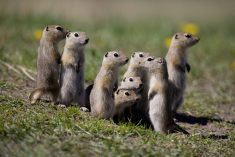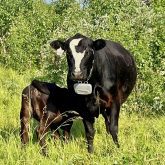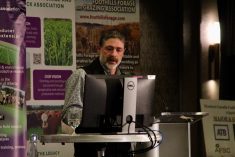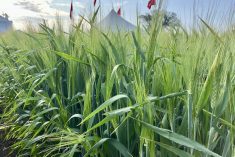As Canada works to reach the goals set in its 2030 Emissions Reduction Plan, many industries, including agriculture, are looking at ways to cut emissions, but discussed less often are measures to prevent them in the first place.
Alberta rancher and custom grazier Steve Kenyon is the lead grazing mentor in the Canadian Forage and Grassland Association’s (CFGA) Advanced Grazing Systems Program, which has been developed to help producers implement systems that help sequester carbon.
“Agriculture is one of the only industries on the planet that has the ability to sequester carbon,” says Kenyon. “Good grazing management can sequester carbon, whereas with poor grazing management, we actually lose carbon from our soil through erosion and harvesting.”
Read Also

Canadian Beef Check-Off Agency reports on investments and activities
The check-off agency’s work behind the scenes is what ensures cattle check-off dollars are invested wisely, accounted for transparently and deliver measurable value back to producers and importers.
Brian McConkey, chief scientist with Viresco Solutions Incorporated, says the key for grazing management to increase soil carbon is to manage vegetation to get it to grow as much as possible and to preserve diversity, including nitrogen-fixing legumes. He says the ideal system is the one that avoids the second bite. “With continuous grazing, the livestock tend to select certain species, but with rotational grazing, the animals have less time on a particular paddock and are less able to continually return to the same plants they like.”
[RELATED] Cattle and climate change: There are always two sides to a debate
What producers can expect in soil carbon gains from rotational grazing will depend on the pasture and where it is located in Canada.
“If you’re doing this on long-term pastures, which are generally fairly rich in organic carbon, it’s not that easy to increase carbon stores,” McConkey says. “However, if it’s a system that has degraded, such as a system that was converted from cropland into pasture, then the opportunity is larger.”
The results will also differ by location — drier regions like the Prairies make it harder to create conditions that add soil carbon.
“You still may be able to provide better-quality grazing through rotational grazing, but the impact on soil carbon will not be so large,” says McConkey, adding keeping a diverse mixture of plants and preserving higher-quality grass during the rest periods will do more for carbon in these areas.
In wetter regions, livestock stress becomes more important, and rotational grazing has more impact.
Tale of two pastures
Kenyon says economics are the best reason for practising good grazing management. To illustrate his point, he recalls Alberta’s 2021 drought and two pastures on his land — one where he has practised good grazing management for over 20 years and another he acquired three years ago.
“Our average rainfall is about 15 inches in a growing season. In 2021, we were under four inches, so a pretty significant drought. The land we’ve been managing for over 20 years, we still had 92 per cent of its average production so, basically it wasn’t in a drought because we have been building it, planning for the drought for many, many years.”
The land they had worked for only three years told a different story.
“Even though when I got it, I thought it was in really good shape, we just hadn’t had the time to heal it, to add that carbon and to build that water-holding capacity,” says Kenyon. “We only got 64 per cent of the average production from the previous couple years, so a major difference. Same rainfall, same area, just the management is the difference. So when it comes down to it, it’s economics for the farmer.”
Kenyon acknowledges there is an economic threshold on how intensively each pasture should be managed. For example, if a piece of land is 50 miles away, it is not economic to travel there six times a day to move fence.
“There is an environmental benefit to good grazing management and the more intense you graze, the bet- ter environmental management is as long as you’re doing it properly,” he says. “However, depending on the situation, your economics might not be there so you have to weigh that out on every piece of land.”
C equals N
Nitrogen is another part of the economic side of good grazing management because, as carbon is added to the soil, it increases the available stored nitrogen. Kenyon says soil microbiology tries to keep this carbon- to-nitrogen ratio at around 24 to one.
“So, for every 24 parts of carbon, we get one part nitrogen. Our fix is to buy nitrogen and add it to the soil, whereas what we should be concentrating on is adding carbon to the soil, which will automatically raise our levels of nitrogen.”
To do that on his farm, Kenyon follows the five grazing concepts of an advanced grazing system, the same concepts at the centre of the CFGA’s Advanced Grazing Systems Program: graze period, rest period, animal impact, stock density and soil armour.
- Graze period and rest period work best together to prevent the livestock from overgrazing the plants. The graze period must be short enough that the plants can’t regrow and be bitten for a second time.
“We call that the second bite,” says Kenyon, explaining that after the plant is grazed once, it has new growth that should not be re-grazed. - The rest period must then be long enough to ensure full recovery of the root systems to ensure the energy stores are replenished before the animals are allowed to come back and graze. The optimum rest period will vary depending on the environment.
- Animal impact includes both the physical and biological impacts. The physical stimulation of the animals moving around on the soil helps with new seedling development, while the biological impact is when the animal’s biology — for example manure and hair — falls to the ground. “The herbivore actually builds the biology in the soil,” says Kenyon. “It assists it and it enhances it.”
- Stock density is the number of animals in a paddock. There are two benefits to greater density — more even nutrient distribution as manure is spread more evenly, and better plant utilization where all plants are grazed, stepped on or knocked over.
- Finally, soil armour the protective layer such as dead leaf and plant material that helps to create water- holding capacity and maintain soil temperature.
Learn more
The CFGA has several resources to support producers in learning about, developing and implementing advanced grazing systems. For producers anywhere in Canada, these include independent learning through the Advanced Grazing Systems online course and learning with a grazing mentor through the Farm Resilience Mentorship (FaRM) Program.
This spring, the CFGA received $10 million from the Government of Canada’s On-Farm Climate Action Fund (OFCAF) to help producers implement rotational grazing. While the CFGA OFCAF funding is only available to producers in British Columbia, Alberta, Saskatchewan and Quebec, the Advanced Grazing Systems online course and mentorship training is open to producers across the country.
For more information visit canadianfga.ca.
– This article was originally published as a supplement in the 2022 Forage & Grassland Guide.
















